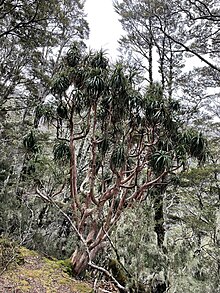| Dracophyllum traversii | |
|---|---|

| |
| Scientific classification | |
| Kingdom: | Plantae |
| Clade: | Tracheophytes |
| Clade: | Angiosperms |
| Clade: | Eudicots |
| Clade: | Asterids |
| Order: | Ericales |
| Family: | Ericaceae |
| Genus: | Dracophyllum |
| Species: | D. traversii
|
| Binomial name | |
| Dracophyllum traversii | |
| Synonyms[3] | |
| |
Dracophyllum traversii, commonly known as mountain neinei, grass tree, and pineapple tree is a species of flowering plant in the heath family Ericaceae. It is a deciduous tree (or, in some cases, a shrub) endemic to New Zealand. It reaches a height of 0.2–13 m (0.66–42.65 ft) and has leaves which form tufts at the end of its branches. It has a lifespan of between 500 and 600 years.
Similar to some other Dracophyllum species, it has a candelabra-shaped canopy; long, thin, green leaves; and a prominent pyramid-shaped inflorescence. It has tiny red flowers, between 500 and 3000 on each panicle, and equally tiny reddish-brown dry fruit. D. traversii inhabits a variety of forest and shrubland types, from lowland to subalpine, in gorges, on cliffs, and on mountainsides. It has a range that stretches from Waima forest at the top of New Zealand's North Island, down to Otago and Fiordland in the South Island.
It was first described by Joseph Dalton Hooker in 1867, and was placed by Walter Oliver in the subgenus Dracophyllum in 1928. A cladistic analysis using genetic sequencing was published in 2010, revealing that D. traversii was indeed related to D. latifolium as Oliver had thought. The status of D. pyramidale as a synonym is disputed by taxonomic institutions and botanists, with Plants of the World Online not recognising the positions of the New Zealand Organism Register, New Zealand Plant Conversation Network, and various New Zealand botanists.
- ^ "Assessment Details for Dracophyllum traversii Hook.f." New Zealand Threat Classification System (NZTCS) Department of Conservation (New Zealand). 2017. Retrieved 29 July 2021.
- ^ Cite error: The named reference
POWO_325087-1was invoked but never defined (see the help page). - ^ Cite error: The named reference
:0was invoked but never defined (see the help page).
